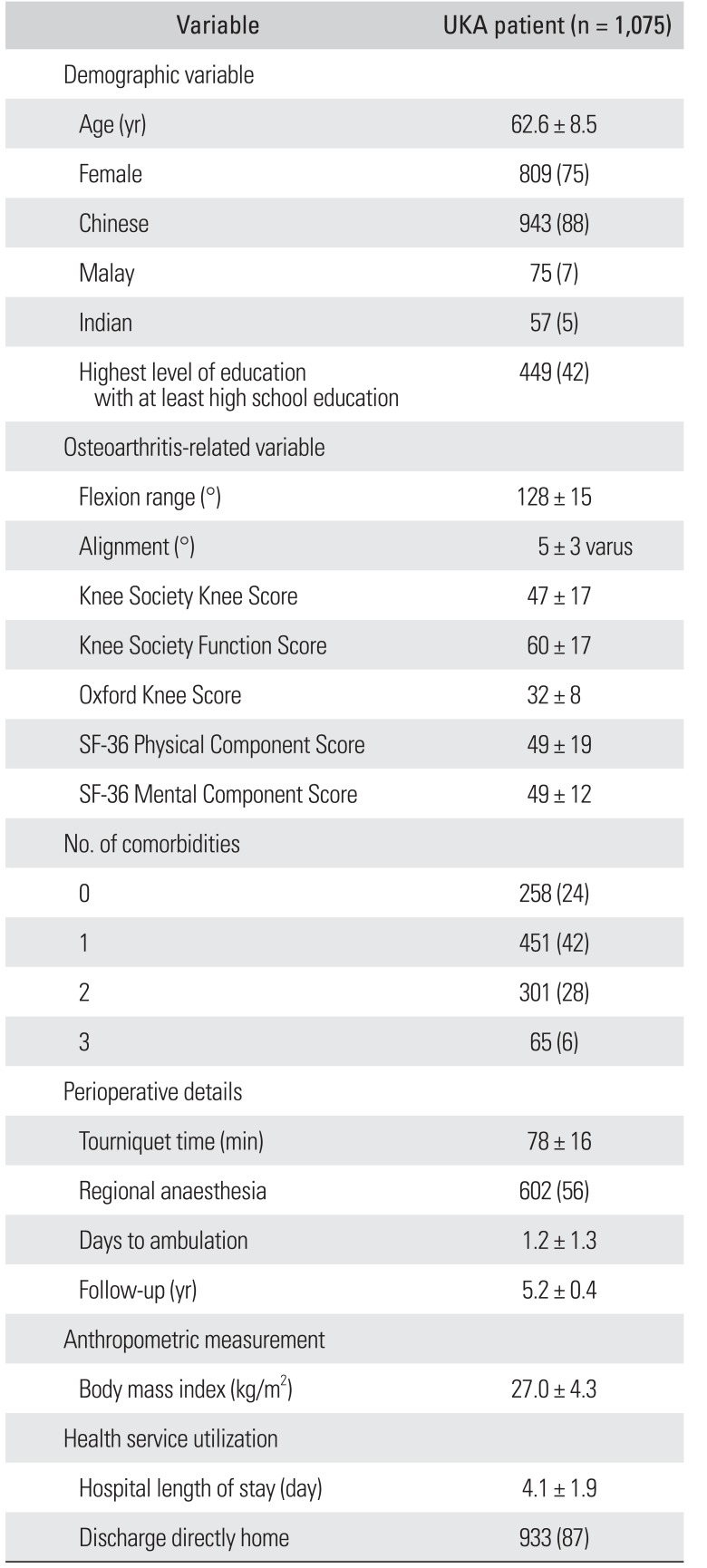1. Morris MJ, Molli RG, Berend KR, Lombardi AV Jr. Mortality and perioperative complications after unicompartmental knee arthroplasty. Knee. 2013; 20(3):218–220. PMID:
23159151.

2. Naal FD, Fischer M, Preuss A, et al. Return to sports and recreational activity after unicompartmental knee arthroplasty. Am J Sports Med. 2007; 35(10):1688–1695. PMID:
17557876.

3. Pennington DW, Swienckowski JJ, Lutes WB, Drake GN. Unicompartmental knee arthroplasty in patients sixty years of age or younger. J Bone Joint Surg Am. 2003; 85(10):1968–1973. PMID:
14563806.

4. Longo UG, Loppini M, Trovato U, Rizzello G, Maffulli N, Denaro V. No difference between unicompartmental versus total knee arthroplasty for the management of medial osteoarthtritis of the knee in the same patient: a systematic review and pooling data analysis. Br Med Bull. 2015; 114(1):65–73. PMID:
25743408.

5. Liddle AD, Pandit H, Judge A, Murray DW. Optimal usage of unicompartmental knee arthroplasty: a study of 41,986 cases from the National Joint Registry for England and Wales. Bone Joint J. 2015; 97(11):1506–1511. PMID:
26530653.
6. Sanmartin C, Murphy K, Choptain N, et al. Appropriateness of healthcare interventions: concepts and scoping of the published literature. Int J Technol Assess Health Care. 2008; 24(3):342–349. PMID:
18601803.

7. Chacko KA. AHA Medical/Scientific Statement: 1994 revisions to classification of functional capacity and objective assessment of patients with diseases of the heart. Circulation. 1995; 92(7):2003–2005. PMID:
7671385.
8. Dawson J, Fitzpatrick R, Murray D, Carr A. Questionnaire on the perceptions of patients about total knee replacement. J Bone Joint Surg Br. 1998; 80(1):63–69. PMID:
9460955.

9. Ware JE Jr, Kosinki M, Gandek B, Keller SD. SF-36 physical and mental health summary scales: a user's manual. Boston: The Health Institute;1994.
10. Insall JN, Dorr LD, Scott RD, Scott WN. Rationale of the Knee Society clinical rating system. Clin Orthop Relat Res. 1989; (248):13–14. PMID:
2805470.

11. Tseng HM, Lu JF, Gandek B. Cultural issues in using the SF-36 Health Survey in Asia: results from Taiwan. Health Qual Life Outcomes. 2003; 1:72. PMID:
14641915.
12. Hawker GA, Badley EM, Borkhoff CM, et al. Which patients are most likely to benefit from total joint arthroplasty? Arthritis Rheum. 2013; 65(5):1243–1252. PMID:
23459843.

13. Wells G, Beaton D, Shea B, et al. Minimal clinically important differences: review of methods. J Rheumatol. 2001; 28(2):406–412. PMID:
11246688.
14. Bozdogan H. Model selection and Akaike's Information Criterion (AIC): the general theory and its analytical extensions. Psychometrika. 1987; 52(3):345–370.

15. Zuiderbaan HA, van der List JP, Khamaisy S, et al. Unicompartmental knee arthroplasty versus total knee arthroplasty: which type of artificial joint do patients forget? Knee Surg Sports Traumatol Arthrosc. 2017; 25(3):681–686. PMID:
26590566.

16. Price AJ, Dodd CA, Svard UG, Murray DW. Oxford medial unicompartmental knee arthroplasty in patients younger and older than 60 years of age. J Bone Joint Surg Br. 2005; 87(11):1488–1492. PMID:
16260664.

17. Parratte S, Pauly V, Aubaniac JM, Argenson JN. No long-term difference between fixed and mobile medial unicompartmental arthroplasty. Clin Orthop Relat Res. 2012; 470(1):61–68. PMID:
21732024.

18. Li MG, Yao F, Joss B, Ioppolo J, Nivbrant B, Wood D. Mobile vs. fixed bearing unicondylar knee arthroplasty: a randomized study on short term clinical outcomes and knee kinematics. Knee. 2006; 13(5):365–370. PMID:
16797994.

19. Jahromi I, Walton NP, Dobson PJ, Lewis PL, Campbell DG. Patient-perceived outcome measures following unicompartmental knee arthroplasty with mini-incision. Int Orthop. 2004; 28(5):286–289. PMID:
15480659.

20. Munk S, Odgaard A, Madsen F, et al. Preoperative lateral subluxation of the patella is a predictor of poor early outcome of Oxford phase-III medial unicompartmental knee arthroplasty. Acta Orthop. 2011; 82(5):582–588. PMID:
21895499.

21. Zuiderbaan HA, van der List JP, Chawla H, Khamaisy S, Thein R, Pearle AD. Predictors of subjective outcome after medial unicompartmental knee arthroplasty. J Arthroplasty. 2016; 31(7):1453–1458. PMID:
26928182.

22. Insall J, Aglietti P. A five to seven-year follow-up of unicondylar arthroplasty. J Bone Joint Surg Am. 1980; 62(8):1329–1337. PMID:
7440612.

23. Kozinn SC, Scott R. Unicondylar knee arthroplasty. J Bone Joint Surg Am. 1989; 71(1):145–150. PMID:
2643607.

24. Xing Z, Katz J, Jiranek W. Unicompartmental knee arthroplasty: factors influencing the outcome. J Knee Surg. 2012; 25(5):369–373. PMID:
23150345.

25. Thompson SA, Liabaud B, Nellans KW, Geller JA. Factors associated with poor outcomes following unicompartmental knee arthroplasty: redefining the “classic” indications for surgery. J Arthroplasty. 2013; 28(9):1561–1564. PMID:
23523214.
26. Jiang L, Bin Abd Razak HR, Chong HC, Tan A. Preoperative patient characteristics and outcomes of total knee arthroplasty in a multiethnic Asian population stratified by ethnicity. J Arthroplasty. 2014; 29(2):304–307. PMID:
23891052.

27. Bin Abd Razak HR, Chong HC, Tan AH. Obesity does not imply poor outcomes in Asians after total knee arthroplasty. Clin Orthop Relat Res. 2013; 471(6):1957–1963. PMID:
23212771.

28. Lee M, Huang Y, Chong HC, Ning Y, Lo NN, Yeo SJ. Predicting satisfaction for unicompartmental knee arthroplasty patients in an Asian population. J Arthroplasty. 2016; 31(8):1706–1710. PMID:
26935944.

29. van der List JP, Chawla H, Zuiderbaan HA, Pearle AD. The role of preoperative patient characteristics on outcomes of unicompartmental knee arthroplasty: a meta-analysis critique. J Arthroplasty. 2016; 31(11):2617–2627. PMID:
27172863.

30. Zengerink I, Duivenvoorden T, Niesten D, Verburg H, Bloem R, Mathijssen N. Obesity does not influence the outcome after unicompartmental knee arthroplasty. Acta Orthop Belg. 2015; 81(4):776–783. PMID:
26790804.







 PDF
PDF ePub
ePub Citation
Citation Print
Print


 XML Download
XML Download